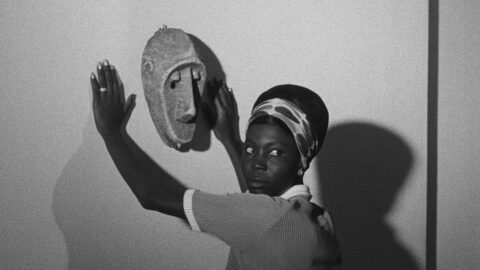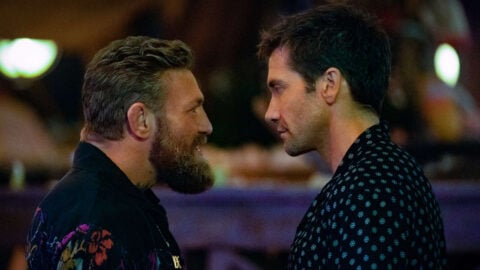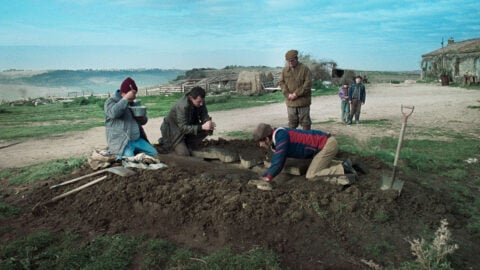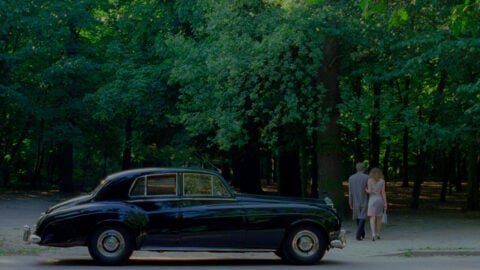Interview: Myroslav Slaboshpytskiy
Myroslav Slaboshpytskiy’s The Tribe signals an achievement of cinema in the purest sense of the word: unfolding entirely in sign language, the movie dispenses with subtitles, but the strength of its visual storytelling renders the spoken word completely unnecessary. Centering on a gang of teenage criminals at a boarding school for the deaf in the Ukraine, The Tribe demands a high level of attention, but it also commands it with its nightmarish coming-of-age tale. Opening with the arrival of an unnamed new kid in school, we watch him withstand initial bullying to become the leader of a prostitution ring, before falling into a complicated relationship with one of the girls he pimps out at a nearby truck stop.
These kids are no joke: Slaboshpytskiy draws on his own experience as a crime reporter to render this fearsome mafia with brutal realism. But while the film is in many ways relentlessly up close and personal—the sex scenes are fairly explicit, the violence particularly visceral, and there’s a real-time abortion scene, the most hard to watch in quite some time—Slaboshpytskiy’s camera maintains a safe distance. Favoring the long shot and the long take almost exclusively, his carefully layered compositions allow the audience to take in multiple conversations and goings-on at once while firmly keeping us (at least those of us who don’t understand sign language) in our place as “the other.”
Slaboshpytskiy, who as a boy studied across from a school for the deaf in Kiev, has made a movie that’s less about deafness than it is about cinema as a medium. The Tribe does not presume to tell us what it’s like to live in a world without sound but merely insists on a form of communication that transcends the conventions of spoken language. On the director’s press visit to New York, FILM COMMENT sat down with Slaboshpytskiy, who is warm and lighthearted in person, to talk about sound and vision.

The Tribe is to some extent an expansion of your 2010 short film Deafness. When did you know the idea was feature-worthy? Did that come as early as shooting the short, or was it after it started to garner acclaim on the festival circuit?
In fact it happened a little differently. I had the concept for a film with sign language approximately 20 years ago but I had no opportunities to shoot it. Deafness was a completely no-budget film: we spent approximately $300. But it’s a very important film for me. I was thinking to myself, how can I make this form of storytelling work? I have a connection with the deaf community—the Ukrainian Deaf Society—and I was using the kind of communication that you see in the short to show people who might fund the film how it was going to look.
The Tribe obliterates the conventional boundaries of “normalcy” because those capable of hearing are re-positioned as outsiders. You wait until quite late in the film to include the sound of voices—when the kids are in line for their passports—and suddenly we remember that there’s a world outside this bubble we’ve been living in for almost two hours. Why did you choose that moment to remind us, as opposed to earlier, say, in one of the truckstop scenes?
The whole point of The Tribe is to have a film from the point of view of a deaf person—when you see these people on the street, it looks like how it looks in the movie. You can hear all the noises on the street in the background, but you can’t hear their words. We were aiming to make a very realistic film, so of course when you have a line at the embassy, you need to hear voices and you need this scene to move the story—it was just organic. When I developed the script, I was thinking about creating situations where I wouldn’t need any people speaking. But for this scene we tried to make it true to the sounds of the city.
You’ve said in past interviews that because this is a movie with no words, the audience becomes co-creators in a way, inventing the dialogue for themselves. Of course that’s different if you’re a deaf audience member, but when you first wrote the script, did you start with the dialogue or did you create broader scenarios and fill in the details later?
I made a number of short films before this, and I always create the plan, the situation first, and finally when I’m finished with the script, I write the dialogue. The dialogue is not really important in cinema. If you can understand Ukrainian sign language, for example, you’re watching the film just like a regular film with dialogue and I don’t think you really know much more. It’s just like a chat in real life: when you’re sitting there talking about something not that important—“How are you?” “What are you doing?” Blah, blah, blah. I don’t think that you get some kind of secret if you can understand the language.

You’ve also talked about the necessity of using very clear-cut, simple scenarios so that the viewer can always understand what’s going on. Were there any scenes that you filmed or wrote and ended up cutting because you found they didn’t translate?
No. Of course, some things changed, but they changed as any film shoot changes. You write this scene in the script to be shot inside, and you see a nice location outside and think, maybe this scene can take place here—stuff like that. But nothing too important. I finished the script in 2011, and in the DVD that’s coming out, the special features will have this version of the script so you can check against it [laughs]. Some scenes ended up a little bit shorter: we had 2 hours and 30 minutes when we started editing, and we cut things a little bit [to 2 hours and 12 minutes]. But not for the reason you mentioned.
The look of The Tribe—mostly long takes and long shots—is hugely important. The long shots are perhaps counterintuitive given that in silent film, faces are crucial to conveying emotion, and they can rely heavily on close-ups. I don’t think we get a single close-up in this film.
We decided to shoot the film like that accidentally. When we shot the rehearsal, we thought it looked very nice. We have a number of reasons for using long shots. When a deaf person communicates with you, he’s using his whole body. We probably could have moved the camera closer to the actor, but when we shot the film we didn’t think a lot about it. We have a lot of movement and a lot of physical activity, like that you might find in Chaplin or Keaton, but of course a moving camera is more modern. We were using the Steadicam.
The school location is also especially important given the shooting style. The long tracking shots through the hallways and connecting doors get across just how well you and your characters know the space. You shot the film in the school you attended when you were young. Was that the intention from the beginning or did it just happen to work out that way?
It’s an interesting question because in part I didn’t choose the school. I looked at different schools all around, but when I was working on the script, I needed someplace to explain to people how it was going to look. So I came to this school. We were looking at a number of locations for about two months, always looking to find something better, but finally I decided to shoot there. The script was based on it, and I know this place very well—it’s a very special place. I know where we used to go to smoke between lessons, where they store the bottles on the third floor, and where the men’s toilets are.

What about the old fairground where the gang members go get drunk? That was quite magical. Is that nearby?
Unfortunately it’s on the other side of Kiev [laughs]. When I was young, we had the same thing very close by, but now it’s destroyed, so we looked for another one. This might be the last one that exists, and it will probably be destroyed soon.
The film relies extensively on repetition, with important variations, to drive the story forward and to convey a sense of character development—with the truck stop and the three sex scenes, for example. Can you talk about your use of repetition in relation to the film’s sense of time?
Yeah, someone was very critical of me about this—they thought that four truck-stop scenes was too much. But in all those scenes something happens, it moves the story along. I’m never thinking about how time is progressing in the film. But I needed these scenes in the truck station—it’s where all the main situations happen which completely change the relationship between the characters.
The film is wordless but not exactly silent—the soundscape is quite rich. We hear the physical noises of signing, gravel under people’s feet, etc. What was your process like with your sound designer, and were you primarily recording on set or did you build the audio in postproduction?
I really love my sound designer, Sergey Stepanskiy. He’s a genius. I’ve worked with him on a number of my short films, and in fact I don’t like to work with sound myself. I never understand music, for example. I never hear it. It doesn’t mean I hate music, but I hear other sounds more. But I don’t like this part of the job—it’s terribly boring for me and I can’t really do much with it for myself.
We had more or less a documentary style of shooting and needed the same effect with the sound, so we recorded the sound in real time. I think everything was recorded on the scene. There was editing in post, but not so much was created. Actually, when the sound designer first showed me the sound, I was extremely unhappy with it. They had absorbed too much of the sound, and it took over the naturalism and absolutely killed the film. To solve this, we decided to just turn it way down. So we never altered anything—the sounds people were making—we just lowered the background.

This is one of the darkest movies I’ve seen, but there’s also quite a bit of tenderness and moments of humor as well. The scene with the girls and the Italians, for example, or the first two sex scenes. How did you manage to maintain a balance between light and dark?
Some directors plan everything out and construct all the emotions ahead of time. I just follow my intuition. If I’m in the moment and I like where it’s going, I just stay with it. In this case, since you did notice there is this balance, I think it’s just following real life. Just as there are these funny moments, awkward moments, and warmth in life, that’s why [they’re in the movie]. It’s simply because I was trying to achieve a sense of real life.







